We know that everyone wants a one-step easy solution and Zinsser mold killing primer and mold killing paints sound grea5-t, but…is it really that easy?
Will mold killing primer and mold resistant paint be enough to protect me?
We recommend this mold resistant paint by a very trusty brand, Zinsser ( check the price here).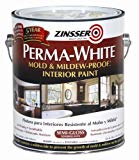
Mold inhibiting paint will not kill mold! (See our recommendation just below for that). The general name is ‘mildew’, and it will grow right through ordinary house paint: you must mechanically remove all you can, then SEAL it with a mold killing primer such as Zinsser mold killing primer. It’s not the nightmare you were expecting, and we simplified it all here.
If you are in doubt as to whether you can use anti mold paint or not, I highly recommend that you call a professional mold remediation company to evaluate what needs to be done. A company like FDP Mold Remediation can handle the worst cases.
A product new to me is Siamons Mold Control. Like BioBarrier, it leaves a film that is hard for mold to grab. If you have a recurrent mold problem and nothing works, get the large bucket and clean with it every time. Considering the health risk, the cost is quite reasonable.
List of what you need before you paint over mold
- Safety first: 3M’s full face respirator mold remediation kit which you see just below…or use the painter’s workhorse respirator discussed in this post.
- Mold killing primer by Zinsser This company has been making primers since companies started making primers.
- Mold resistant paint: Rust-Oleum. Totally trustworthy brand
- More below on these: Non-toxic prevention solutions: BioBarrier has great reviews. We link to two other very good products below. The other is Siamon’s Mold Control which comes in buckets or spray bottles.
- Bleach is very deadly. Our preferred products are better and safer (linked just below). If you use bleach, click on the link above to the respirator and DEFINITELY wear it. Open windows and blow fans. People die from improper use from bleach.
- Quality rubber gloves: these will last forever.
Trying to become mold-free
After painting with a mold killing paint, inhibit growth another way in damp areas with a non-toxic spray that remains effective for 6 months. This plus the special mold resistant paint will make your life easier (and safer).
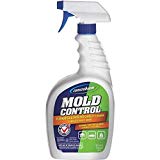
My new favorite is Siamons Mold Control. Unlike bleach which leaves some spores to multiply again, this stuff whacks ’em. A new product I have not tried has 10’s of thousands of great reviews: RMR-86 to remove the mold stains. Let me know how it goes?
Ceiling mold? Bathroom mold, garage or basement mold? You will use the same routine to kill and cover it. Ceiling mold may be the hardest on that list because it is over your head: you will need special protection for your eyes and face from dripping solution and your mold killing primer and your mold resistant paint.
Hard truth and the secret of moldy freedom
It’s hard to find a company willing to say they can kill mold because mold is everywhere. If you have moisture, and especially if it’s dark, you will have mold growth. And it does not die easily like James Bond. Well… Anyway, here is the bototm line: you have to stay on it. There’s no easy way.
My best recommendation…this works for my moist basement… is to use a de-humidifer year-round. Yes it eats electricity, but it’s only like a light bulb. You have to pay that cost and it’s worth it to stay mold free. That’s my opinion.
Then there is UV light bulbs. See below on “Prevention”.
6 easy steps to paint over mold
- Don’t breathe the spores: put on your respirator (our article on respirator mask simplifies the weird world of respirators). Scrape off any loose mold and recover it for disposal.
- Don’t be tempted to use bleach: it’s deadly and will make the problem WORSE. Thanks to a generous reader who pointed out that bleach can make the mold that survives (there is always some) stronger and faster to multiply.
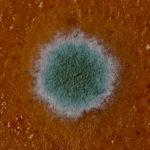
- Put rubber gloves on for any toxins: don’t go dollar store on this one: re-use quality gloves many times over. This prevents chemicals from touching the skin. There is no reason to take a risk with your health ever.
- Wipe with any rag until no more black/green comes off.
- Rinse the surface with clean, wet rags. Leave rags outside away from people/animals.
- Let dry – your first coat should be a mold killing or resistant primer, then two coats of mold resistant paint.
If you have a very large area to treat, you can use a sprayer with your mold killing paint (please wear protection!) You would not want to use your garden sprayer here as the plastic will probably not handle the bleach solution well. Conversely, a sprayer that works with bleach will probably also be fine with garden solutions. Bleaching inside can be very deadly: choose from the respirators above.
We like this eco-safe mold-killer which comes in large one- and 5-gallons as well as spray bottles. Spray and let dry. It leaves a mold-blocking film that can be painted. We use a garden sprayer to apply solutions like these as well.
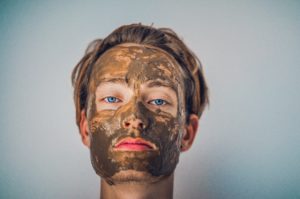
At the end of the post is a video of me breaking the rules killing some mold in our garage: I should have had gloves on, but could not wear a respirator and talk to you!
Careful with manufacturers’ promises: don’t trust the ads that make that claim they have a paint to cover mold or kill mold
When you hear about anti-mold paint, it is not a mold-prevention paint and certainly not a mold killing primer.
Mold inhibiting paint can only resist, not prevent mold, You will make a fortune if you can invent a one-step mold killing paint! There is what is called a mold killing primer: Mold killing primer by Zinsser makes good claims, but let’s be reasonable. It depends on the situation.
Important points for the paint to cover mold
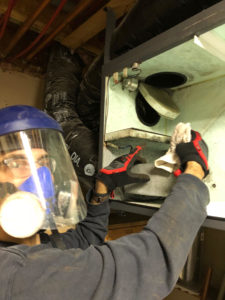
If you have powdery mold sitting on your surfaces, do you really want to mix that into your walls for the future, or leave it for someone else to live with? Just follow the steps above to paint over the mold and you’ll have peace of mind.
Also, the stain mold leaves behind must be totally sealed or it will bleed through your latex paint. Zinsser Mold Killing Primer just says, “aides in covering residual microbiological and fungal stains”. Not good enough, sirs.
For serious stains, get a quart of shellac-based BIN primer or by the gallon. We use it as overkill or as we say “Over Kilz”. Rubbing alcohol is the solvent. We have an entire post about painting over stains. It’s very messy so wear gloves and don’t inhale, Bill.
Again, the respirators at the top of this post will protect you.
We follow our primer with the best mold resistant paint: the Benjamin Moore Aura mentioned below.
I have some other posts on the procedure for painting a room and some professional-tested time-saving tips we learn as professional painters.
Flat, Satin or Semi-Gloss?
 Through my 30+ years as a painter, I have seen the trend change from “always semi-gloss in bathrooms and kitchens” to “anything goes”. The chemistry of paint today allows you to do whatever you want, but still flat and matte paints finishes are naturally going to hold water longer than shiny paints: but they look better! So most people compromise with satin and eggshell. If you keep a bathroom or high moisture area clean, you will not have mold and mildew growth. It’s actually the easy way.
Through my 30+ years as a painter, I have seen the trend change from “always semi-gloss in bathrooms and kitchens” to “anything goes”. The chemistry of paint today allows you to do whatever you want, but still flat and matte paints finishes are naturally going to hold water longer than shiny paints: but they look better! So most people compromise with satin and eggshell. If you keep a bathroom or high moisture area clean, you will not have mold and mildew growth. It’s actually the easy way.
Colors?
You will find some gorgeous bathroom paint colors on the internet. Keep in mind that smaller rooms benefit from lighter colors and more light inhibits mold growth.
What we do
Mold paint does not kill mold! It inhibits growth. So after you do the prep described on this page, choose THE+BEST paint. We recommend always using the best paints you can afford as it’s less cost in the end as we have written, it is a money-saver and you don’t have to paint as often.
For bathrooms and other high moisture areas where mold loves to grow, we recommend Rust-Oleum. The technology behind it is a formula to lock out moisture and prevent or deter mildew/mold growth.
Fixing a hole where the rain gets in?
Flex Seal Liquid Rubber makes sealing leaks easy
Before you replace a cracked sink or floor etc, it’s worth a few bucks to try to seal it and a product I discovered at Home Depot Flex Seal paint. You’ll find Flex Seal at Lowes as well as online. I fixed my cracked garage sink with a liquid sealer and it kept me from replacing it!
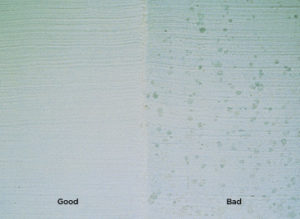
Health Dangers of Mold in Your Home
Some people are more sensitive, but mold affects everyone. Symptoms of mold exposure can include:
- Nasal and sinus congestion, runny nose
- Respiratory problems, such as wheezing and difficulty breathing, chest tightness
- A cough
- Throat irritation
- Sneezing / Sneezing fits
Thank you, Wikipedia.
One Ingenious Pro Tip: Every time you dip a brush into a can of this nasty primer, you are sacrificing that brush. You don’t mind? Do you have a dollarstore brush or an oldie? Sure, but how many will you kill each time you spot some mold or stain that you know you must prime?
What do pros do? We leave a crappy brush in the can for life. If the can is small, we cut or break the handle. After weeks in the can, is it all mushed up and bent? Yes So? It’s wet and ready! Unless we have a large area to seal, we don’t care. The brush strokes from a primer will usually flatten out when dry and if not, will sand fairly well. Faster…Better…ALMOST FREE!
Prevention
 Certain mycotoxins can be harmful or lethal to humans and animals when exposure is high enough.
Certain mycotoxins can be harmful or lethal to humans and animals when exposure is high enough.
An easy way to prevent the growth of mold in dark and/or damp areas in your home is the use of a UVC lamp. Research shows that UVC lamps kill mold, the airborne allergens, bacteria, viruses and protozoa in your home or office. Ultraviolet light breaks up the DNA of mold and mildews which results in the sterilization of the mold.
We tried a hospital-style UV wand but found that it gobbled up batteries, then even with new batteries did not work anymore. Now we will switch to a plug-in type compact germicidal bulb/wand in our mold areas. Hospitals use it.
Prevent mold growth:
- Increase ventilation and sunlight or UV bulbs if possible
- Clean surfaces with strong cleanser or a safe mold killer (don’t use bleach)
- Check nearby plants for mold
- Bright light inhibits mold growth
- Don’t leave very wet towels/puddles around
- Use mold-killing primers and mold resistant paint
- Just be glad it’s not the old days when they put mercury in mold paints as a fungicide.
- Thanks, science
Remember:
Black, gray, green, brown, it’s moldy and it stinks and it’s a health hazard. Don’t just paint over it even with a mold killing primer and a mold resistant paint: you have to clean it safely first!
We used this mold test kit and found penicillin and one other: not deadly, but just sayin’. You can test 3 different times per kit.
PS read about mold and mildew on Wikipedia, the Overlord of us all.
Let me know in the comments if we left anything out. Thanks.
How to Paint over mold video.
This video uses bleach which we have since learned is not good to use: it’s not just deadly to us, but allows some spores to survive and multiply even faster. Use the BioBarrier or Siamons above.
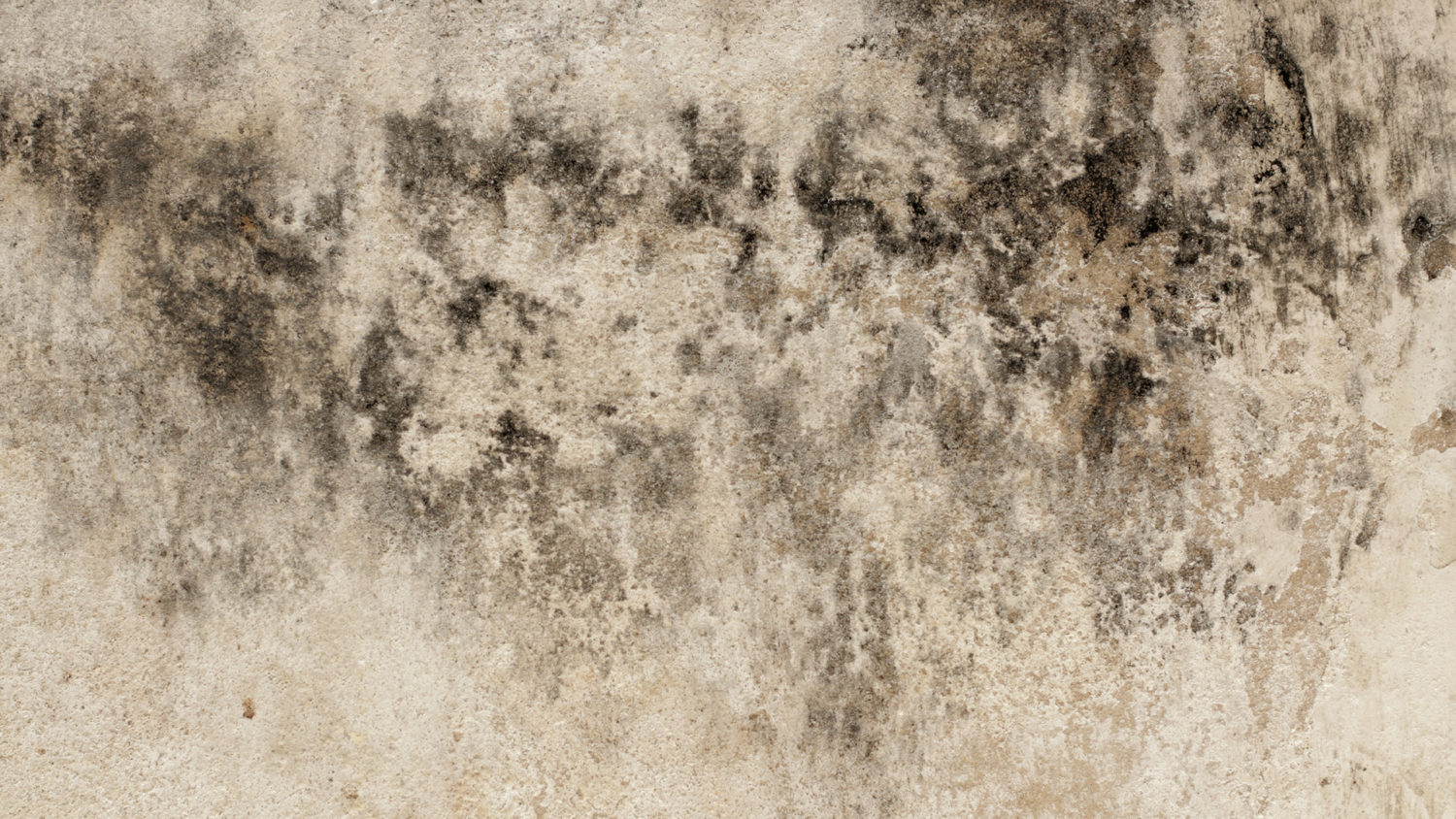
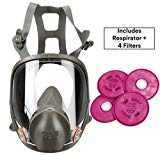
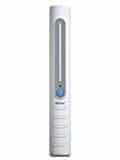
thank you
Hi Brad. I recently had my bathroom renovated and the contractor used ceiling flat all over including the shower area. There is a frameless shower enclosure with about 8 inches open space to ceiling. Needless to say a year in we are having bubbling of the paint over the shower head from the humidity. I now painted an extended square of about 3 inches on the ceiling over the shower with Benjamin Moore kitchen and bath high humidity paint I had around from a past project but it’s a china white and not ceiling white and satin as opposed to flat. Can I paint over the high humidity paint when dry to blend back in with the rest of the ceiling? The 2 tone now looks like a “shadow “ of the shower on the ceiling. Thanks for your help!
Yes, if the new paint is bonded well, whatever you put over it will be ok, assuming all is latex and not greasy etc.
Test with your fingernail to see if you can scrape off any: if yes, it’s not bonded and will fail early…back to square one.
Use a bathroom paint only, not whatever you had. Steam warps paint!
“Contractor” my butt. I bet he was about 20 right? Anyway, you seem to be on the right path.
Brad
Thanks for sharing
I’m purchasing the house. Mold was discovered in the basement during the assessment. The sellers have agreed to make the necessary repairs. “Sand and paint wood in basement” is all that is written on the repairman’s invoice. Will we be able to destroy mould if it has been coated with paint after he takes control of the house? Will we have to first remove the paint?
They should rip out the wall to find how deep it goes and you should when you own it, keep it dry and bright.
Get a mold expert to asess. Don’t trust the seller to do the reapirs. You’ll have the same problem. Find the extent and get money off to do the repair yourself. Don’t budge on that. They’ll just paint and it will come right back and you won’t get the money out of them. My opinion.
GOod luck!
Hi Brad,
Thank you so much for this informative article. I live in a condo in 100 year old school building with big metal window frames. The windows create a lot of condensation (I know replacing them would be ideal but can’t afford that at the moment) and black mold collects all around the inside of the window frames and window wells. Can I prime the metal window frames (in addition to the walls and wells) with the mold killing primer after I clean them?
Thanks again for your generous help to all of us.
That is your best bet.
Of course, clean well, use a mold killing spray and prime as you said and paint…then keep it as dry as you can. I have one of these.
Thanks so much for the help!
Brad, I’ve used Twenty Mule brand Borax (in the laundry aisle) & water solution (1 cup per gallon) to clean up mildewed wooden furniture – it worked really well, the mildew/ mold just wiped off after spraying the solution on & waiting 2 minutes. Mixing Borax with water creates hydrogen peroxide, which a natural germicide and fungicide. Almost totally rid the piece of musty smell. Used shellac to seal the raw wood, and that totally banished the smell. Good to know about the Zinsser primer, I’ll use it on surfaces I’ll paint.
Awesome thanks.
Hi Brad,
We purchase an old home that has porous pine wood ceilings, walls, and floors. The home was left without air conditioning or heat running for 2 years which resulted in a good bit of green mold. The home is historical, built in the 1900s so we really would like to keep the wood. We’ve taken the following steps: fogged each room twice with Concrobium, HEPA vacuumed everything, we have an air scrubber and dehumidifiers running 24-7, we’ve scrubbed down the walls with dish soap and water (drying using fans). Next, we plan to spray walls down with Concrobium, dry, apply Zinsser Bulls Eye 1-2-3 5 Primer and Sealer, and then paint with Zinsser Perma-White Mold & Mildew-Proof satin paint. I know it isn’t ideal to paint over mold that is alive or dead. However, I do not think it is possible to remove every particle of mold from the porous wood. I think encapsulation of the remainder is my only option to avoid having to remove the wood. I would love your thoughts and any suggestions.
Thanks for any help you can provide!
Sounds ok. Yes paint over dead mold is better than nothing, but if it’s moist, you will alwasy have a problem.
I just consulted with a health professional and learned about ozone generators. Kills mold, but must be used with care.
I plan to write a post. Do some research (feel free to share with me as I write).
A good primer also in your case is going to be key. Use a shellac primer: alcohol based.
Thanks so much for the suggestions! Started researching immediately and based on research and reviews I ordered the Enerzen High Capacity Commercial Ozone Generator 11,000mg Industrial Strength O3 Air Purifier Deodorizer Sterilizer. This is a fairly inexpensive measure that may help. The home is vacant so I feel confident we can take the necessary precautions with the ozone. I plan to do air and surface testing prior and after, I’ll let you know the results.
Good morning, thanks for all the advice. I have some green mold spots that appeared it seems from some long room darkening curtains. I’ve cleaned the wallpaper with straight vinegar and even hydrogen peroxide. The stains are lighter. Do I need to remove the wallpaper in that area? What mold primer do you suggest? Also do I then need to paint with mold blocking additive? The area is about 2 ft by 6 ft. Thanks again!
Yes remove the paper: keep it wet for 10 minutes or more and it will almost fall off. You’ll need a scraper. Then under will be paint probably.
Scrub, even sand any mold as long as you don’t harm the surface.
Use this primer.
If you have no more dark area, you probably will not have mold again, so any paint will do after the primer seals it.
Good luck.
Hello Brad,
I’m glad I found your site. We have a summer house with an enclosed, screened-in front porch that’s in sunlight much of the day. The ceiling is plywood with exposed rafters – all of which have been painted numerous times over 50 years.
This week we discovered that since closing the house for the winter last October, the black mold has gotten much worse on some sections, but not others. The flat surfaces (plywood)are very bad; the beams are not as bad.
Also, when we had the roof for the entire house replaced 15 years ago, some sections of the porch roof had rotted and needed to be replaced. They’ve been painted maybe twice in 15 years, with Killz and only have a few spots compared to the original sections.
Considering the sunlight the porch gets with sun on 3 sides and all the windows, you’d think that the black mold wouldn’t grow as much. But the air on that porch goes through some big swings which I believe causes condensation on those flat panels.
So – just to be clear – my best bet is to :
Kill all of that mold first
Wipe each area with rags
Rinse each area and let dry
Treat with a mold-killing primer
Paint with 2 coats of mold resistant paint
Thanks for your help!
Sorry to hear all this. When you get this all done, definitely get a dehumidifier for all the wet months.
You have a good plan, but how to kill the mold completely is the weak link.
Even straight bleach will not kill it all, but there are some mold killers that promise 100%. That is your best bet. If any spores survive, they will all come back.
It’s your health so I’d hire a pro, or some specialists and at least pick their brains and see what needs to be done. A painter with a sander/grinder may be able to take all the wood down below the mold, then really protect it.
Don’t rely on specialty paint to stop it or prevent new mold. Rely on removal and that is going to take money.
Sunlight need to be direct, even glass filters the UV which impedes mold… this is my current understanding. bright light only helps somewhat.
Get many opinions and then spend the cash, then keep it dry!
Good luck,
B
Bedroom….previous owners put sheetrock over a fireplace. 1800’s home.
Im seeing perling paint and a few places where a spotty flower looking black mold comes thu.
I treated with peroxide in a spray bottle…the spots….but im still really concerned.
I originally had planned on uncoveri g the fireplace but have decided thats more work and money than im willing to do.
How do i mold proof, cover where the paint peeled, and know that it wont come back?
Hi. Well, I’d rip some out and see if the mold goes all the way thru. If not, and it’s just surface, get one of the mold killers on this page and really clean it, then a primer that will block it permanently, but still… is that good enough? If it was my house, I’d rip it all out, but that’s me. Mold is potentially dangerous. Get some professional advice in person.
Good luck
B
Thank you for your quick response. Its reslly appreciated.
Gin
thanks! we will let it dry out after cleaning it as you advised- and hold off on the painting
how do you really know the mold is “dead” before you try priming and painting? (we are killing mold under a sink that had leaked and the previous owner of the townhome let mold grow there for who knows how long)- Or now that I’m thinking about it, should we just hold off painting underneath the sink all together (the leak has been resolved)? Thanks for any advice.
I guess a biologist could answer that…but for a painter, we just kill it with something more than bleach (which we used until lately when a biologist wrote and said some always survive bleach).
So, use the products you see on this page above, and the best mold inhibiting primer and paint you can get… You should be ok. One never knows so yes, put it on your annual calendar to check it.
Key point is of course, keep the area dry and the air moving!
Good luck,
b
Can any of these paints be tinted a medium-dark teal?
I fairly sure the answer is yes. All paint is white on the shelf with some having more airspace than others to allow for more tint in some than others. So the dark colors can leaves more space than lighter ones. Definitely ask your paint store if you buy the paint online, and find out what they charge to tint a paint they don’t sell. Might be off-putting.
Good luck
b
I am allergic to the chemical they add to paint to impede mold. Discovered 1993 when it was only in porch paint and is now in lots of caulk, etc. Do you know what that chemical that sends me to the ER is?
No, I’m sorry, but please don’t use even ‘eco’ paints. That’s a VOC thing. I don’t think your allergy is to VOC, but what do I know. I’m writing a post on non-toxic paints, but things move slowly here. Check this site out. Good luck and as soon as you can, get a respirator with chemical filters. They will be back on the market soon!
I have an under-the -sink area with a serious mold problem. The surface is untreated wood, and the mold has sunk into the wood. I have been using various cleaners, but I am very sensitive to chemicals as I have breathing issues. I have tried a hand-held UV light, proving it up and leaving it on, but it has only partly helped. Some of the mold primers say they are for non-porous surfaces, but mine is definitely porous. What mold-killing primer could I use here that would also seal the surface and allow me to paint over it, without driving myself out of the house with
any toxic smells?
Two things. First since you have sensitivies you should call in a pro. Once they get the mold killed, yes seal it with some mold killing primer and mold preventative paint.
But they can only do so much if it’s really wet. Nothing stops mold in the air and it likes the dark.
So the main thing is dry and light.
Really, call a pro and get this out of your house.
Sorry I cannot be more help…
Always use zero VOC paints for the toxins, but don’t handcuff the pros when they come in: go to a motel for as long as it smells.
Good luck.
b
Sorry for the delay in my answer: I was away for a bit.
Nice!
Thank you so much to these 6 Tips. These 6 tips really help me to, how apply mold resistant paint .
Hi, Thanks Brad for taking your time to answer my question. I think I know what to do now. I will try to clean it and primer with either the Zinsser mold killing primer and follow with the best eggshell top coat (not sure which brand) it will be at least a Behr or better, and maybe replace the fan with a bigger one though it has a pretty good one now. under most cases the current fan is more than enough, but you weren’t able to tell me how to take care of the other part of my problem lol. Guess I’m on my own. I will try to keep up and see if you ever test the earth lime primer if this doesn’t work or I will be tearing it out to replace. that is probably the best idea since I don’t know if this sheetrock was part of the recall but it will have to be a last resort. Hope it is ok to say GOD bless you and again Thank you, Jon
Oh, I forgot part of your question.. sorry. First, I looked up that bad sheetrock. What I read said it come from China when there was a shortage after Hurricane Katrina. I doubt you have it, but you certainly have mold, and it does migrate into the rock. I don’t think you need to rip it out, but I’d drill a hole in the worst part and look at the cross-section.
I am working on a post about the Earth Paint. The owner is sick right now: an old painter who was made sick by toxic paints over his lifetime. Check back in the spring for that, but yes, from what I hear, it’s very good against mold. If you try it, please write to me again?
And please let me know how the mold fight goes?
Good luck…best of luck.
b
hi, Thanks for the info. I prefer using the 20 mule borax for light to medium black mold. after I scrub the wood with it and let it dry over night. I then come back with bleach to remove the stains. the borax seems to do well at keeping the mold away longer than others. This is on unfinished floor joist. I now have another issue that may be making us sick. my 30 yr. old daughter and now her 12 yr old son take 45 min to over a hour long steam baths. I have a exhaust fan in the room but they won’t use it. I can go in after her shower and it will be like it is raining on my head, the walls are soaked. I have tried to stop it but my wife defends her. so now the room is mostly covered in mold. this has been going on for 10 yrs. I don’t know what to do because I am not really able to tear it out and put up new also it was put in right about the time the Chinese sheet rock was recalled for being contaminated with I don’t remember but I believe mold. I too was considering trying the lime primer followed with lime sealer. I don’t know about it and it is very expensive. I would of course try to kill and remove as much as possible of the mold before painting it. thing is unless I find a way to get them to stop the stem baths I don’t know if anything will work long term. Any ideas on how to get grown children out. thanks and keep up the work
Hi. Well, I cannot see it but my guess is that if you clean it very well one time, then use this product that leaves a mold-inhibiting layer, BioBarrier, you will have an easier time.
It might be best to clean, kill-mold (Siamons is best I feel), then paint with mold-inhibition paint, it would be a good fresh start.
I just updated the post: I added the link at the top of this page, adding that to the BioBarrier. It’s hard to know which is best. They both come in spray bottles too.
So either the Siamons or the BioBarrier: clean regularly.
It’s a low price to pay for a healthy living space.
Leaving the fan on for an hour after the steam bath is important too.
A dehumidifier would be great too.
b
Sorry my comment is suppost to say undeluted peroxide. And Zinzer primer. Sometimes my phone spells for me. Thank you, Kim
🙂
Hi Brad, I paint a lot of old furniture. A lot of it has had mold on it. I have used undelivered peroxide to clean it before painting it. I usually use zinger oil base primer before painting. My question is, what’s the best thing to use to remove mold on furniture before painting? Also will you still see mold spots after using a mold cleaner? Even if you don’t paint it, what will remove mold and spots from wood furniture? Thank you, Kim
First wash with water very well, not bleach and dry in a warm area. THen spray with either this or this.
I’ve recently learned that bleach allows a few spores to live and they grow more quickly.
There is also the idea of the germ bulb…UV will kill it all very thoroughly.
Then either oil or water-based primer depending on your wish. Not that important. What is the main thing? Killing it before you prime.
Good luck!
Hi there!
Do you have experience with Earthpaint Lime Primer? It seems to make a lot of sense, and perhaps safer than mold-killing additives, but I don’t know the science.
I am partially finishing an unfinished basement. The exterior walls (rough parging on stone or concrete) are painted white with a waterproof basement paint. We had a dehumidifier but it evidently stopped working and we got mold on the walls. I treated it with a solution of borax and water, which I left on for a while. My painter was planning now to paint it over with Kilz2 or a similar primer, and asked me to confirm that this is what I wanted him to do. And doing research online, I came across the Earth paint lime primer, and would love to know what you think. I would prefer not to use the Earth paint lime paint, as I spent a lot of time picking out Benjamin Moore colors oh, but I could be persuaded. Thank you so much!
Hi. Well, first of all, get rid of that painter. When you hire a professional, he or she should know what is needed and not need to ask you if you want to use this or that product.
My best advice is to interview other painters on the phone and ask what experience they have and what they recommend. Older painters would be much better here.
The method I use is mold killing spray, wash, and then mold preventative primer and paint. Then, as you know, to try to keep the air moving there and humidity down. Mold hates light also.
I also don’t know the chemistry behind Earthpaint but from a quick reading of some online info, it does look good based on what the maker says about their own product. Can that be trusted?
I sent a message to them asking for independent test results… I’ll add any worthy reply here.
Best wishes, and good luck on the fight!
b
Did you ever hear back from
The company about lime prime?
Ah, you know they did not reply. I just looked it up again and it seems no primer is necessary.
I’ll look into lime paints and do some writing on it. Feel free to forward any info: we can help others.
Feel free to write me anytime…contact email in footer of every page.
Our basement flooded a year ago (8′ of water!) but we got everything dried out very quickly. Unfortunately, we developed mold on joists in one of the small crawl spaces because it hadn’t been properly excavated and was a moisture trap. I just finished digging it out to 2′ below the joists and then putting 15mil plastic down and up the walls with everything sealed. I’ve sprayed the joists several times with a hydrogen peroxide + baking soda solution. I scrubbed them all once and have wiped them down a couple times. Each time I put a fan in there and dried everything out. Dehumidifier is also running and humidity is down to about 45%.
While the joists do look MUCH cleaner, there are still visible dark spots on most of them. I’m now planning to paint all the joists with a sprayer and Kilz Premium. is this a bad idea? With the plastic down and then connecting to our HVAC system, I’m pretty sure we can keep the moisture level down below 55% year round. Seems like encapsulating what remains would be better than sanding and potentially making a mess of everything. On the other hand, I don’t want to make the problem worse for us 10-15 years down the road.
Once I had a basement with wet walls making the house moldy. We tried plastic using Great Stuff as a glue between the sheets… Not so effective. I hope you can find a way to seal the wet out with the plastic.
A pro is always worth the consultation fee.
I’m no expert on mold in wood, but what you are describing sounds reasonable… The black spots you see could be live mold or stains from dead spores. Yes, you should use the Kilz Premium (alcohol-based which is better than the water-based, but have rubbing alcohol to clean your hands)… but before this primer, use a mold killing spray, not bleach and not just the baking soda (which is very good) but you want to be sure. So really take time to kill it.
Some products:
This is the mold cleaner I have been recommending. Let me know if you find a better one. It’s a good company.
Also, this is supposed to be very effective.
After the Kilz, it could not hurt to lay a thick coat of mold primer
Use BIN spray for tight spots as well.
Also use a topcoat for mold prevention
So, while I cannot see your case, my advice is that what you know to be a potential problem with overwhelming force… and keep an eye on it each year.
Good luck,
b
Ps you should have a good respirator, esp if you spray with the BIN and for mold in general.
My son is buying a house. The inspection showed mold in the basement. The sellers have agreed to fix it. On the invoice from the repair people, it merely states “sand and paint wood in basement.” After he takes possession of the house, will we be able to kill mold if it has been covered in paint? Or will we have to remove the paint first?
Good question: I would not accept the repair slip. I would tell the seller that before your inspector is satisfied, he will do a mold test by removing some of the repair paint. If there is mold, you will not accept. So they should do it right the first time and rip the sheetrock out or in some way totally remove it.
There are companies that remove mold. Some Joe Schmidt painter does not know what he is doing and does not care because it will look fine for a year and he’s long gone.
Also, Don’t use bleach. I’ve just learned and I will be updating all my posts about mold that bleach is not the way to go. Use a mold killing solution.
Get involved with the seller. Show them this reply to your question.
Mold comes right back. It will be everywhere in a year.
ALso pick up a dehumidifier and use it every spring and summer whenever it’s humid. But that is no replacement for removal.
Hi, I have mold embedded in the walls. I have rock/stone walls and the there’s block walls that I’m dealing with I went over the walls with vinegar & bleach water when I ran out of vinegar. I went back to the first wall and discovered that there was more specks of mold on it than the first time. I’m guessing it may not have dried good enough. I have picked and picked the block walls but it seems like every time I allow it to dry there is more that has accumulated and in some parts looks like chocolate chips. I am willing to seal it in it was told that the zinsser mold killing primer doesn’t actually kill the mold and wasn’t good to use. So I went out and bought some Thompson’s masonry water seal. Have you ever use this and doesn’t work? I believe it says on there that it resist. I’m just worried and if I use it on the front, the mold will go through to the other side and come out? Any info on this would be greatly appreciated as I have spent the last two months in my basement trying to kill all the mold. What is good to use floor Joyce’s up above? I and also having a problem with the basement floor. It is mostly concrete but has cracked and crumbled there’s parts that’s just dirt. I have discovered that most of the dirt is mold and there is mold under the concrete. I am about to pull my hair out with this. Makes me wonder if I should have just went ahead and paid the $1,800 and gave it to the professionals instead!? Tia!
I doubt mold could grow back that fast: you probably killed it and are just seeing the stain from the spores. Anyway, if it is stone, can you pressure wash it? That is a mechanical way to remove most of it, then spray with one of the safe killers linked above: not bleach!
Then the mold primer etc as you mentioned.
Hard for me because I cannot see it, so I can only imagine what you are describing.
We don’t like Thompsons: too many complaints. We tend towards the big makers: Sherwin Williams or Benjamin Moore.
Sounds like you have mold everwhere: why not get a professional’s price and pick his brains on what he would do. SOrry I cannot help much more. DOn’t pull hair! Yes, go with the pros.
Hi Brad,
I would appreciate your thoughts. I have an end unit 3 br townhouse built in 1982. I have had mold remediations done but now may have found the source. Upstairs with no mold showing, we cut 3 holes on back, side, and front walls and behind was mold and plastic sheeting. I guess the plastic was a vapor barrier.
I am researching if KILZ or something else could be painted on the walls that will seal the
mold in. I looked at the Rustoleum product but it does not seal.
Yes, it’s tricky to stop moisture. Now that you already have a problem, I’m wondering if you can prevent ripping out the old rock, putting new insulation, if it’s wet, or damp, and putting up new rock. I need to write an article about this, but I’m no expert. This document should be good reading for you. THey found 2 coats of a vapor barrier paint to be effective in a controlled test. In a case like this, don’t consider anything but Ben Moore or Sherwin Williams, the 2 best in the biz. The product I have used, and of course I painted and never heard from the customer again, was Ben Moore’s Ultra Spec® Latex Vapor Barrier Sealer. Until I study this more, I cannot be of more help. Try the Ben Moore info line: https://www.benjaminmoore.com/en-us/contact-us
Good luck,
b
If you use the BIN do you still use zinsser mold killing primer too?
Hi. No, just one primer is enough. Just make sure the mold is dead first. The safe killers linked above are really better, but if you use bleach, ventilate well–it’s deadly. Good to have the respirator we describe on this site. Good luck, b
Oh my goodness absolutely desperate for help with no answers for months and you might be the guy to help us please please please!!!!
We are in the process of building a tiny house. It’s a 12×32 shed. The bedrooms are lofts and the rest downstairs. During the winter we started with propane heat… Started noticing moisture.. like a lot of moisture. ( Keep in mind we don’t have drywall up yet. At this point we only had insulation up.) So we quit using the propane and switched to electric heat cause it’s a dryer heat. Thought it would help. When we hit some warmer days this year. We noticed a TON of moisture. Dripping down from the loft areas, the insulation was falling cause it was so heavy with moisture, so we closed off loft 2 cause we thought it was cause that side doesn’t get much sun. Well then we got two days in a row of 75% weather and the entire ceiling line was soaked with condensation thru the insulation. It was dripping off the insulation, we had puddles, it was draining down the walls, condensation was following the electrical lines, everywhere. Thruout this entire time, we have also had this mold (grey / black) that has been where ever this water has been. At this point this mold was speckled all over the insulation and on parts of the wood of the ceiling. So we took all the insulation off the ceiling and threw it away. So downstairs has insulation but the lofts do not and a small fraction of downstairs has drywall. I took bleach water and a scrub brush and scrubbed everything I thought looked like mold. Not like scrubbed scrubbed but like enough to get the bleach into it. It had been a couple days and we are back in the lofts.. but my husband and my daughter got sick again and I’m having episodes again 🙁 … ( I have bradycardia, syncope, and I have moments that mimic seizures but they aren’t… Doctor’s are still working on it).. but I thought I had got it all but I’m having second thoughts and I’m fighting so hard to figure out what to do, what’s causing it now, how to stop it, how to fix it, how to prevent it, why did we get so much moisture, do we need to ventilate? So many questions and we have talked to so many people but no one can seem to help us. Can you please give us some advice as to what we are doing wrong?
Hi. Wow, what a story. First, when using bleach, you have to wear a respirator and any time around mold, wear it. The post we have selected the best for this purpose is here: buy it for life.
As for where the moisture is coming from: the air. A dehumidifier will help a lot.
You were right to use bleach: now that the bugs are dead, cover them with a mold-inhibiting primer and paint shown in this post above.
I cannot say what you are doing wrong, sounds somewhat normal: we all have to deal with moisture. New woods will give off moisture for some months too.
Take care of your health first: maybe the tiny house should be sold? Is it worth it? Maybe be patient and see if the problem eases with time? Spring is a wet time as all the bugs will tell you.
Best wishes,
Brad
YIKES!
There are two kinds of gas heaters (natural gas, propane, whatever – open flame or catalytic combustion): vented and unvented. Unvented heaters dump the combustion products into the air in the room. Those combustion products include WATER, Carbon Dioxide, and Carbon Monoxide (which can sicken or kill you). Unvented heaters are intended only for use in well-ventilated (drafty, unpleasant) spaces.
The only type of heater you should use in a house is a VENTED heater. These almost always cost more dollars – but paying for heat with sickness or death is too high a price. A vented heater brings air in from the outside, and exhausts the combustion products to the outside.
The fact that you have all this water and you are getting sick almost proves that you have an unvented heater. PLEASE! don’t use it. REPLACE it.
Sorry to be so insistent, but this is important and not everyone knows it.
Thank you very much: I updated her by email.
Brad
Hi, I am looking to put down new flooring in my below grade basement on my concrete floor. I would like to choose the best product that will allow the vapor to evaporate, or not create mold on the laminate flooring that I put down. I’m pretty lost reading up on all of this. Would you have any suggestions for a flooring product. Seems the floor sales people do not know about these issues. Thank you, Audrey
Hi Audrey, If you want to spend some money, ask a flooring store about click flooring: the fake wood stuff. They lay a thin layer of cork under it and it breathes… I THINK. We have it in 1/2 our basement and the other half is painted.
If the concrete is not damp, you can paint and just read on our post on this site about ‘basement paint’ and it gives some steps and product suggestions. Key point is that it cannot be moist when you do it. If you paint, you’ll not have to deal with mold (assuming you kill all the existing mold… bleach the heck out of it, but wear a respirator (search this site for ‘respirator’ … our post points to the one to keep you safe)… Bleach in that quantity is lethal, so be very careful. Maybe hydrogen peroxide is better but much more expensive. Then let dry totally…heaters and fans and windows open etc, then paint or do flooring. Regardless of what you do, make sure you kill the existing mold and cover when bone dry, if possible. Good luck.
Any suggestions for mold forming on patio steel ceiling?Open on all sides, but ceiling has no areas of ventilation.
Hi and thanks for writing. You already have your finger on the problem, no ventilation.
Mold hates bright light and dry air. I’m assuming this area will get very cold:
Outdoor paint is needed here, so I’d scrub with a bleach solution (wear a respirator…see my post on that), then prime with KILZ General Purpose Exterior Latex Primer, then outdoor paint…then…. of course, you have to get some air moving.
A dehumidifier would be a last resort if the space is really air-tight. Remember, you are breathing that mold…your ceiling is like a canary in a patio coal mine showing you what is in the air. Good luck.
Good luck,
B
I am having a mold issue throughout my house. I noticed a spot on my baseboard and by the next week all of my wood furniture seemed to be covered in green mold. I live in Florida in an older home with a crawl space and terrible ventilation. Right now I am battling the mold inside my dresser. What is the best product to use to seal the mold inside there when it is MDF? I cleaned it with a mold killing spray and bought flex seal but am now wondering if I bought the wrong product? Thank you for your help.
Sounds ok to me if you used a primer with lots of stain killing power. See the post on primers…not all are created equally.
I probably would have used a brush with the liquid and not a spray as the cost is much less and spray is so nasty.. but in any case…go ahead with your next coat. Start over an area you know had bad staining/mold and let dry. See if it bleeds thru. Depending on the stain killing primer, it will probably not.
Brad,
Thanks for the information. I have been battling a few areas of mold/mildew in our fixer upper (due to a refrigerator water line break). I have found that using Concrobium to clean the moldy/mildew areas first and then let dry before applying the Zinnser Mold Killing Primer. Is that what you would say is the best? Also, how long would you recommend letting the area dry between the cleaning process and laying down the primer?
Thanks
Steve
Hi Steve, yes it seems like a good plan. If this reply is late in reaching you, sorry, but how did it go? If not, you should have no problems if you paint any water-based paint or primer on a dry surface. If the wall is wet deep inside, that is different, but I suspect you just had mold on the surface…let’s hope so. You can always dig out a spot and look, then fix the hole with spackle.
Yes the Zinnser is the best on the market.
Good luck!
Hi Brad,
It was very kind of you to acknowledge my message. You’re absolutely right! Mold is a scary, serious, nasty issue. Hurricane Matthew: (more water) insurance company said 4 feet down but I had the entire house gutted to the studs. I didn’t want to wonder if anything was growing, anywhere! Hurricane Irma: (stronger wind) new roof down, top to bottom and much more energy efficient.
My issue is a pretty bad finishing job on the drywall. Humps, bumps, mesh tape showing through, the whole nine yards.
Thanks again!
-L
It was my pleasure.
In Colorado (I was there for 20-ish yrs) most walls in homes and apartments are textured.
I always preferred it but I’m in a home now where it’s normal flat wall, so it’s not worth texturing.
With texture, you don’t need to sand much of the taping mud, just basic smooth and then they spray the mud, let dry and in new construction or like yours, they would spray paint just because it’s quicker: at least the primer and ceilings. If you have no furniture etc, you can mask the newly painted trim then paint walls almost up to the ceiling, then you are almost done.
But the roller is fine too. If you hire a guy to spray, get an older painter: over 40 who has been in it a long time!
I live now in a seaport city where for 10 yrs I don’t think I’ve seen the humidity go below 50%. This summer I had a leak in the room where my well enters the house…blah blah, but the point is I pulled out some very moldy sheetrock near the floor. The studs behind had no mold to my surprise. The backside of the rock had just a little at the bottom where it soaked up water several times. So again, your studs are probably fine. You could test in spots by cutting holes with a hole saw and look with your phone’s camera stuck into the hole with a flash…easy to replace a hole. This guy is doing a lamp but it’s the same thing.
B
Thank you so much for the articles on your website! I am in a very difficult, scary spot. Gut after Hurricane Matthew, less than a year later gut after Hurricane Irma. I was told the drywall was primed and ready for painting. It is not. That is not just my opinion. It is the evaluation of professional painters.
For financial and time reasons I am going to need to do this myself. I have learned so much from you and I just wanted to thank you profusely for sharing your knowledge online. I keep telling myself “I can do this!” Thank you Brad! — L
It was my pleasure to help: 35 years go into my posts.
If you still have moisture, be careful not to seal it in. Mold grows inside the walls too and it is a dangerous thing.
Some lawyers will give a free consultation and might be able to help insurance companies part with a few extra coins.
Good luck
Brad